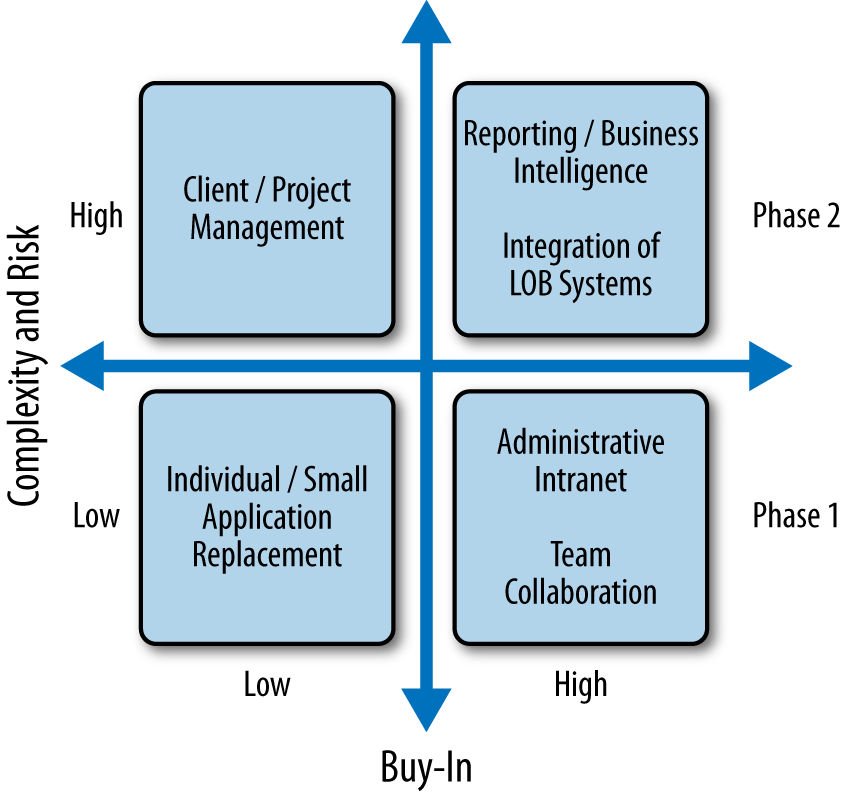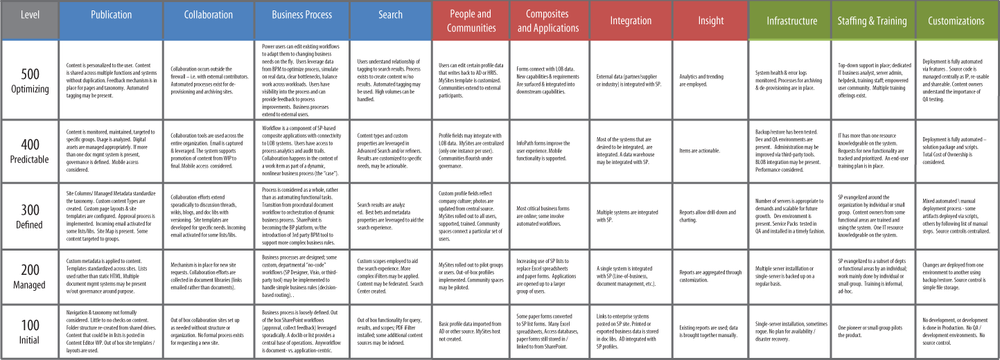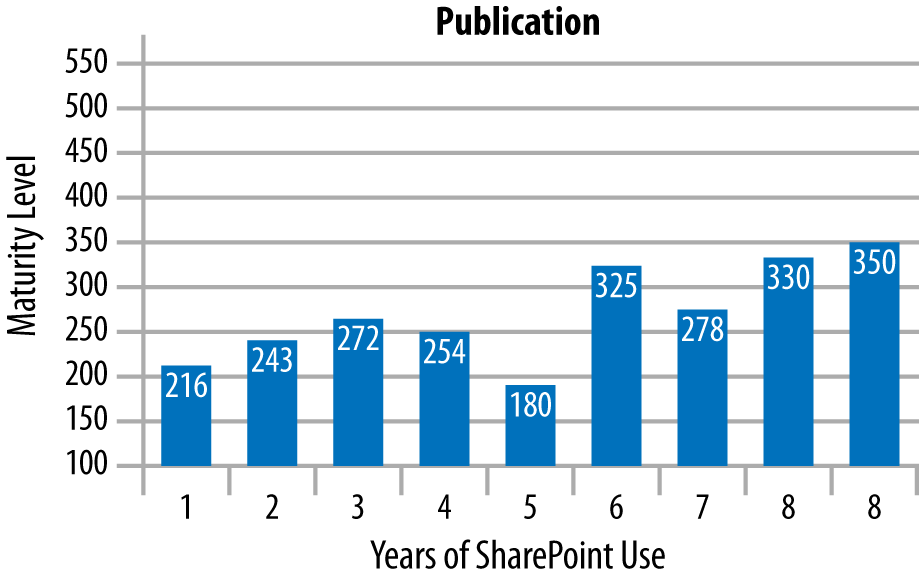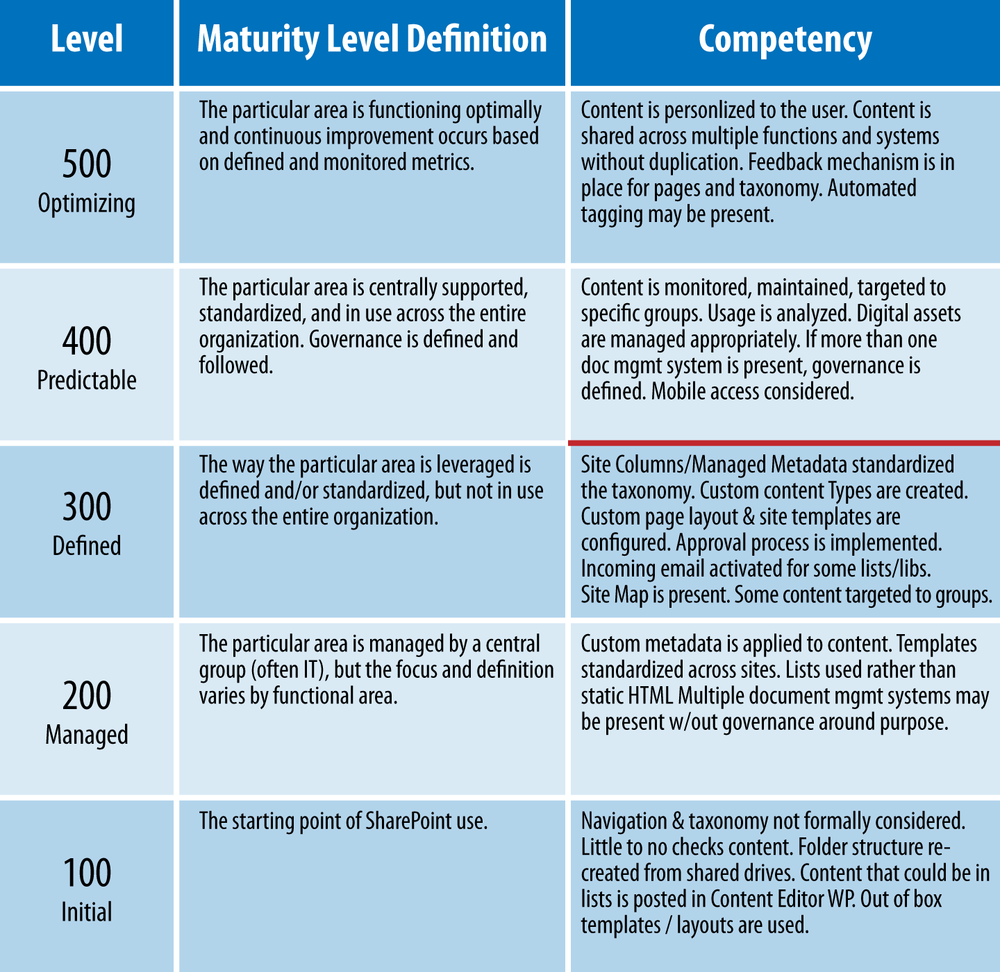Chapter 1. The SharePoint Maturity Model
Sadalit Van Buren
How well does your organization use SharePoint? You probably can’t answer that in any quantifiable terms, much less speak about how the various components of SharePoint are working for you.
With SharePoint’s explosive popularity and adoption worldwide, a community of SharePoint experts has formed with the goal of sharing knowledge about this product. The authors in this book, as well as hundreds of others, dedicate their time and energy to help organizations understand and use the product, and have made a galaxy of resources available for different areas of functionality.
What’s been missing is a cohesive way to analyze and understand the platform as a whole. Organizations don’t know what they have, and they may be focusing too much on projects that yield little return, missing the quick wins, or declining to invest in areas that could truly transform their businesses.
I created the SharePoint Maturity Model to apply a holistic view to a SharePoint implementation and to bring standardization to the conversation around functionality, best practices, and improvement. My goal is to allow organizations to reach the full potential of their investments in SharePoint, and the SharePoint Maturity Model is the framework that enables this.
Evolution of the Model
My work as a SharePoint consultant, starting in 2006, gave me a perspective over many different companies and implementation types. I noticed there was a typical progression of SharePoint projects and the issues surrounding them. Most companies were working toward the same initiatives and struggling with the same challenges, though most saw their efforts as unique to their environment. Many clients hired us because we helped “other companies” solve the same problem. Other than anecdotal evidence, there was no way to truly compare organizations’ use of SharePoint.
In 2009, when Microsoft Office SharePoint Server (MOSS) 2007 made SharePoint a viable platform for a broad range of companies, I expressed the trend of implementation as a quadrant of Complexity and Risk vs. Buy-in (see Figure 1-1), where companies typically started with the “low-hanging fruit” projects and saved the more culture-changing and resource-intensive projects for later.
With the release of SharePoint 2010, it was obvious that the picture was much more complex than this. A few other SharePoint experts had attempted to set out a model of SharePoint maturity, but these were limited to specific segments of the technology, such as deployment and collaboration. At this time, I was also seeing an evolution in the community’s thinking, from largely technical to more business-focused concerns. I was frustrated with the mostly tactical, technology-oriented conversations I kept hearing about SharePoint, and I had a vision for a standardized way for people to talk about their implementations and a means for them to benchmark against others and show progress over time, which is critical to justifying investments in IT.
In the Fall of 2010, I created Version 1 of the SharePoint Maturity Model and, with the support of Mark Miller, published it on EndUserSharePoint for community evaluation and feedback. The enthusiastic response it received showed there had truly been a need for this kind of tool, and suggestions from many community members have led to continuous improvements since its release. Since then, organizations of all sizes, from 20 users to 40,000 users, have assessed their progress against the Model. A selection of the current data from these assessments is available on SharePointMaturity.com.
Structure of the Model
The Model has 5 maturity levels and 11 competencies, which are divided into three groups: core solution competencies, advanced solution competencies (both of which are oriented toward the technological, tool-based side), and readiness competencies (oriented toward the environmental, human-based side).
The maturity levels follow the five-level standard set out in the Capability Maturity Model (see Table 1-1) and many other models, and describe the processes around implementation of the platform. These levels and competency definitions are not specific to SharePoint 2010, but can be used for 2010, and will be updated when the features of Wave 15 are released from Non-Disclosure.
Level | Definition |
500 | The area is functioning optimally and continuous improvement occurs based on defined and monitored metrics. Return on investment (ROI) is demonstrable. |
400 | The area is centrally supported, standardized, and implemented across the entire organization. Governance is defined and understood and followed. |
300 | The way the area is implemented is defined and/or standardized, but not in use across the entire organization. Governance is defined, but may not be widely understood or followed. ROI is considered. |
200 | The area is managed by a central group (often IT), but the focus and definition varies by functional area or is limited to a single area. |
100 | The starting point of SharePoint use. |
The core competencies are where organizations typically focus first, because they tend to yield greater results with lower investment and often serve as an update to systems or functionality with which the business is already familiar. Table 1-2 describes the core SharePoint competencies.
The advanced competencies (described in Table 1-3) are so named because they tend to be simultaneously more culture-changing and more resource-intensive. They may introduce concepts or functionality that are new to the End Users.
The Readiness competencies (described in Table 1-4) are common to most technology systems, and are critical to a successful SharePoint implementation.
Together, the 11 competencies and the 5 levels create a matrix, shown in Figure 1-2, that describes the best practices and indicators for each competency level.
Applying the Model
The SharePoint Maturity Model can benefit you at three levels:
- As an individual implementation owner
If you are responsible for your organization’s SharePoint implementation and you have been struggling with adoption, business alignment, and making the case that there really is a return on your investment in SharePoint, the model can help you define your strategic roadmap and give you a quantitative sense of your progress when you reevaluate periodically. This can demonstrate the need for increased resources and will put clearer definition around which projects should take priority.
- As part of your organization
Taking the time to evaluate your implementation and making continuous improvements based on your roadmap will ultimately lead to greater business process efficiency, happier and more empowered users, and a more stable SharePoint environment. The assessment can also help define ROI for upgrades or additional feature implementation.
- As a member of the wider SharePoint community
By assigning a number value to your current state in the competencies, you are helping to build a data model that will help answer larger questions about where organizations are in their SP maturity—by industry, number of years of use, the number of IT staff supporting the implementation, etc. (Figure 1-3).
The Model also has practical applications within your business, such as:
- Project triage
Evaluate new project requests against the Model to determine whether your implementation can support them.
- Staffing considerations
Know where and when specific resources will be needed as you move upward in maturity.
- Risk assessments
Understand where the risks are in undertaking projects that are at a higher maturity level or that depend on related competencies where your maturity is not as high.
- Training
Develop a curriculum for individuals and functional units based on their implementation’s maturity level.
- Products and services
When you’ve determined the competencies on which you’ll focus, you can quickly get a sense of which companies and tools can help you get to the next level.
These examples should give some idea of the potential of the Maturity Model as a powerful tool for expanding and demonstrating SharePoint’s influence on your business. Now we’ll go through one of the competencies, publication, to see how an organization might progress through the levels and realize some of these benefits.
Focus on Publication
As with all the competencies in the SharePoint Maturity Model, the five levels of publication are identified by distinct characteristics (see Figure 1-4). This is not intended to be a comprehensive list of all possibilities, but is a framework for an organization to recognize the markers that define its level.
Let’s say we’re looking at a product company with several global locations and just over 1,000 employees. The company has a homegrown intranet that is nine years old and receives a lot of complaints from the employees—it’s difficult to update, the home page is confusing due to a large number of links and buttons, and there is no overall search functionality. It is integrated with a content management system that is no longer supported. Everyone agrees it needs to be replaced.
The CIO does some informal benchmarking with her colleagues at similar companies and finds that SharePoint is the current platform of choice. She has her senior business analyst do some research and product evaluation of several content management systems to confirm the decision to go with SharePoint.
Level 100—Goals and First Steps
The company’s main goals for the launch of the new SharePoint-based intranet are:
Provide a streamlined home page with restructured navigation for easy browsing to all sections.
Build out fully functional sites for human resources, finance, and information technology with emphasis on publication of current policies and procedures. The rest of the departments will follow in a later phase.
Provide full-text search of all content across all sites.
Introduce “People search” based on the company’s Active Directory.
In the first six months of the project, the SharePoint environment is built and an IT project manager and business analyst work with the three key departments to move their content from the old intranet to the new one.
At the end of this effort, IT does a soft launch by redirecting the three old departmental intranet pages to the new sites and putting a basic welcome message (which includes a list of Hot Links) and pictures of the company’s locations on the home page. The global navigation has five tabs: Home, News, HR, Finance, and IT. The current navigation on each page reflects the SharePoint defaults with headings for Libraries and Lists.
Level 200—Lists and Navigation Links
After the soft launch, the marketing and communications department is invited to review the home page. They see it as a way to publish news and company events, including the all-important holiday schedule, and the department wants to brand it with the company colors. The IT business analyst creates lists for Announcements and Events, and an additional list for Hot Links, to replace the text-based list that was included in the Welcome message. Permissions are changed on these lists to give members of the marketing and communications department the right to contribute to them. Although the senior visual designer has many years of CSS and web design experience, branding SharePoint is complex and different enough that the team decides to hire an outside consulting firm to do this work.
During this phase, IT is also reaching out to other departments and functional areas to migrate their content from the old intranet to the new one. The IT business analyst creates a standard department template and uses this for each new site. Although most of the departments would like to have a link directly from the global navigation bar, the business analyst knows it’s a best practice not to have too many tabs, so he creates a Departments heading and rolls HR, Finance, and IT under that tab, as well as any new department sites that are created. For any departments that are not ready to move their content, he creates a navigation link to their old intranet sites.
At this level of maturity (200), the employees have instant access to their holiday schedules—no extra clicks to a PDF document, hunting through their email, or calling HR for the most recent list. They can also access any site from any page in the intranet, and they’re starting to rely on the SharePoint intranet as a place to find information from all departments, with a standard user experience across the sites.
Level 300—Defining and Standardizing
As the department sites are rolled out, the IT business analyst hears a need for location-specific information to be shared and posted. As employees travel between offices, they want quick insight into the local weather and news headlines for the different locations, plus the company-specific details for each location, such as building access policies, the approved car services, and other information. In the past, there had been no dedicated owner for such information, but now the business analyst works with HR to designate a content owner in each office who will post his location’s specific information. The business analyst converts the location pages into individual sites, each based on a standard Location template. Behind the scenes, he sets up site columns to standardize the company’s much-used lists: Departments, Office Locations, and Product Lines. He uses the Location metadata to deliver filtered views to the local holidays on each location site.
Changes are happening on the home page, too. The consultants have delivered a new master page and stylesheet that incorporate the company’s primary and secondary branding colors and give the web parts and navigation elements a more rounded look. The Hot Links on the home page are now targeted to specific audiences. On the Departments home page, the IT business analyst uses the Table of Contents web part to create a Site Map to help employees browse all the new sites that are being created.
In a parallel effort, as the company’s Collaboration maturity improves, employees are able to provision their own Project sites, and a navigation link is added to this new area.
As the company moves into the 300 level of maturity, the site has more visual punch as it streamlines the way content is delivered. Employees are really seeing the benefit now. The most critical information is targeted to them on the home page, and they are able to drill down quickly to find what they need by department, location, and product line. New employees are trained in using the intranet on their first day, and they use it to learn about the company. Within any list or library, content owners can use standard metadata for location, product line, and department. From site to site, there’s a familiar look and feel.
Level 400—Monitoring and Maintaining
The marketing and communications department has gotten some great feedback on the new home page, and it actively monitors page hits to see if this translates into real numbers. The IT department wants to maintain the positive momentum for the new site, so the business analyst is tasked with keeping an eye on what employees are searching for, and with developing a process for creating new content for any queries that yield no results.
Publication on the intranet is getting a bit more social, too. The CIO has started writing a blog on the IT department site, and the IT business analyst has added the NoteBoard web part to the Project site template so project team members can give quick updates. The business analyst is also given the responsibility of reading and responding to issues and comments that are submitted via the new Feedback link that appears in the header of all pages.
As more and more employees use the intranet during the work day, they feel supported by the Feedback link, because they receive prompt responses to their comments. The IT business analyst had expected to receive more bugs and issues than suggestions, but he soon needs to create a new category in the feedback list: Great Ideas. So many people in the company are thinking about the intranet now that the IT business analyst feels the truth of the saying, “All of us are smarter than any of us.”
Level 500—Planning for Personalization
The next change the CIO is planning is a big one: personalizing the content in all the top-level landing pages of the site. To achieve this, the IT business analyst will need to work with all the content owners to change how they deliver content, from basic storage and display to a directed, well-thought-out plan for publication and dispersal. They are also planning to bring the increasing social activity into the light by adding web parts that display most-viewed content for a site, most recent searches, and top-rated content.
We’ve followed this fictional company through the stages of publication maturity at a rapid pace, rather like a time-lapse film of a flower blooming. The reality is that this kind of progression represents a major investment of time and resources, not just by IT staff, but by all the content owners in the company. It requires changing culture and work habits, learning new tools, and leaving the comfort zone. It’s helped along by executive support and by a commitment to making the time for this new system, instead of just piling the tasks onto an already overflowing workload. In this story, there were no loud naysayers, no silent saboteurs, no talk of inadequate budget or of how IT’s other responsibilities got done. Many companies are already quite good at being resistant to change and not investing enough time and resources in transformative projects, so I don’t see a need to discuss this. I’d rather create a vision of what the ideal could be, what SharePoint publication could be at its full potential.
Evaluating Your Own Publication Maturity
As you consider the publication maturity of your intranet, ask yourself these questions: How well does it succeed at being a one-stop shop for information? When employees browse for specific content, are they successful? Does the taxonomy, layout, and structure of the intranet—its information architecture—make sense, and can it evolve as the company evolves? Is the content static or dynamic? Is it directed to everyone equally, or targeted to specific groups, or personalized to the user? Do employees trust that what they see there is fresh and well maintained? Do they have a consistent and intuitive user experience as they travel from page to page? All these considerations define your publication strategy and together will influence its maturity and success.
Summary
If you are trying to get your arms around your SharePoint implementation, decide where to invest, and demonstrate progress, the SharePoint Maturity Model framework can help you. I developed it as a veteran of over 50 SharePoint implementations, and it has been vetted and refined by experts around the globe. It will evolve as the product evolves, and it will guide your implementation through its own evolution, providing direction to the iterations and phases that lead to a mature solution.
If you’d like to learn more, and find the tools and resources to do a full self-assessment, visit SharePointMaturity.com.
Get SharePoint 2010 at Work now with the O’Reilly learning platform.
O’Reilly members experience books, live events, courses curated by job role, and more from O’Reilly and nearly 200 top publishers.





